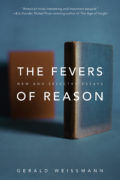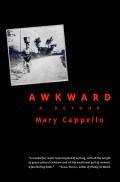“The Lives They Left Behind is a deeply moving testament to the human side of mental illness, and of the narrow margin which so often separates the sane from the mad. It is a remarkable portrait, too, of the life of a psychiatric asylum—the sort of community in which, for better and for worse, hundreds of thousands of people lived out their lives. Darby Penney and Peter Stastny’s careful historical (almost archaeological) and biographical reconstructions give us unique insight into these lives which would otherwise be lost and, indeed, unimaginable to the rest of us.”
Oliver Sacks
-
on
“Fascinating. . . . The haunting thing about the suitcase owners is that it’s so easy to identify with them.”
Newsweek
( link)-
on
“In their poignant detail the items helped rescue these individuals from the dark sprawl of anonymity.”
New York Times
( link)-
on
“[The authors] spent 10 years piecing together a handful of poignant biographical narratives, tracking down medical records, talking to former staff and using artifacts from the suitcases as clues to the lives these patients lived before they were nightmarishly stripped of their identities.”
Newsday
( link)-
on
“This book should be required reading for anyone who struggles with the treatment of mental illness in community settings.”
New England Journal of Medicine
( link)-
on
“No reader will walk away untouched by these compelling portraits.”
Ronald Bassman, Ph.D., author of A Fight to Be: A Psychologist’s Experience from Both Sides of the Locked Door
-
on
“An important and profoundly moving story. . . . The exquisite details we learn about the patients’ lives—the color of lace on a dress, a plea to a bishop, the photo of a wife who died—convey the particulars of their humanness, their strengths, and their tragedies, and a chapter revealing sad and frightening parallels between long-ago and current treatment of many people called mentally ill should shock us all into action.”
Paula J. Caplan, Ph.D., author of They Say You’re Crazy: How the World’s Most Powerful Psychiatrists Decide Who’s Normal
-
on
“Darby Penney and Peter Stastny have . . . performed an important service, reclaiming these individuals from the nameless, faceless fate of being only ‘mental patients.’”
Judi Chamberlin, author of On Our Own: Patient Controlled Alternatives to the Mental Health System
-
on
“As we have yet to provide a full measure of support and treatment to men and women diagnosed with mental illnesses, The Lives They Left Behind offers a sobering reminder of past tragic errors, lest, in our search for new therapies, we lose sight of what should matter most: our sense of common humanity.”
Drew Days III, Alfred M. Rankin Professor of Law at Yale Law School, former Solicitor General in the Clinton Administration and Assistant Attorney General for Civil Rights in the Carter Administration
-
on
“In unpacking the prior lives stored in these suitcases, Darby Penney and Peter Stastny turn remembrance into an act of alchemy.”
Kim Hopper, Ph.D., author of Reckoning with Homelessness
-
on
“A unique and mesmerizing evocation of lives erased . . . at once unnerving, heartbreaking, and a bitter testament to an era in psychiatric history whose legacy is all too present today.”
Gail A. Hornstein, Ph.D., author of To Redeem One Person Is to Redeem the World: The Life of Frieda Fromm-Reichmann
-
on
“The Lives They Left Behind is a tour de force, a must-read for anyone concerned with social justice, human rights and historical reclamation. Darby Penney and Peter Stastny brilliantly rescue ten people who spent time at Willard State Hospital from certain historical anonymity and silence by giving them voice to speak for themselves. Their riveting accounts invite us to explore the turmoil and strengths of their inner terrain while mourning the erosion of hope after years of captivity and inhumane treatment in the name ‘help’ and under the guise of ‘best interest.’ The Lives They Left Behind is more than a testament to the past, it is a wake up call to our collective conscience, to uphold the spirit and dignity of all human beings.”
Laura Prescott, President and Founder, Sister Witness International Inc.
-
on
“A stunning achievement.”
Robert Whitaker, author of Mad in America (from the Foreword)
-
on
Willard State Psychiatric Hospital, overlooking Seneca Lake in rural upstate New York, housed more than 54,000 people during its 126 years of operation. Some were released to their communities after decades of institutionalization, but many more died there. If not for the discovery of 400 suitcases filled with patients’ belongings in the hospital attic when the facility closed in 1995, their lives would have been lost to history. This discovery led the authors—a psychiatrist and an ex-patient advocate—to conduct a detailed study of the lives of the suitcase owners, to curate an exhibit at the New York State Museum in Albany that attracted more than 300,000 visitors, to speak to audiences across the country about the lives of the suitcase owners, and to write this book.
In The Lives They Left Behind, the contents of ten of these suitcases are skillfully examined and compared to the written record to create a moving and devastating group portrait of twentieth-century American psychiatric care. Richer, more complex lives than indicated by the hospital records emerge from a wide array of personal effects, including letters to loved ones, photographs of school chums and foreign travels, knickknacks, religious tracts, a christening gown, professional photographic equipment, and a delicate hand-painted bone china teacup and saucer. Here are gripping personal dramas of new immigrants and native-born Americans, men and women of different races and ethnicities, among them a young, dispossessed German nun, a Scottish nurse, a Filipino student, and an African-American World War II veteran. These people coped with a host of problems in times of war, economic hardship, and cultural dislocation. The confusion following displacement, the rage or despair resulting from illness, loss of loved ones, or sudden poverty, and the experience of hearing disembodied voices were only some of the misfortunes that put them on the path to institutionalization, from which most did not escape alive.
As it restores the humanity of the individuals it so poignantly evokes, The Lives They Left Behind reveals the vast historical inadequacies of a psychiatric system that has yet to heal itself.
Excerpt from The Lives They Left Behind
The Sheltered Workshop Building stands alone on a hill overlooking Seneca Lake next to the empty lot that once held Chapin Hall, the massive central building of Willard State Hospital in New York. When that towering, meandering structure was torn down in 1988, the institution lost its architectural heart, leaving a scattered bunch of buildings that housed nearly a thousand mental patients until the state finally decided to abandon the entire facility in 1995. That spring, all remaining patients were distributed to other institutions. Curators and state workers roamed the grounds, trying to safeguard anything that might be worth keeping before the buildings were condemned. They scurried from building to building, determined to beat the looming deadline of the demolition crews.
Beverly Courtwright and Lisa Hoffman, two local women who worked at Willard, knew the place intimately. They guided Craig Williams, a curator from the New York State Museum, to the spots that offered the most promise for finding important artifacts. Beverly remembered that there was something stashed under the roof of the Sheltered Workshop Building. She led the group up the steep staircase to the attic and then to a door in a partition under pigeon-infested rafters. Once the door was pried open, they were struck by an awesome sight: a beam of sunlight streaming down a central corridor that separated rows of wooden racks tightly filled with suitcases of all shapes and sizes—men’s on the left side, women’s on the right, alphabetized, labeled, and covered by layers of bird droppings, apparently untouched for a great many years.
Crates, trunks, hundreds of standard suitcases, doctor’s bags, and many-shaped containers were all neatly arrayed under the watchful eyes of the pigeons who had come to join the lost souls and their worldly possessions. For Beverly and some others who saw it, this upper room exuded an unearthly air, a hovering presence of hundreds of souls or spirits attached to the many people who had handled and worn the items in those bags before they were packed, who had read the books, written in the diaries, and looked into the mirrors they contained.
Craig Williams, realizing that he had stumbled across a dream of a treasure, called for additional trucks to salvage the luggage. “Just keep ten, and throw the rest away,” he was told. Fortunately, Craig ignored this order, and within hours, all 427 suitcases were wrapped in plastic and driven to the museum’s warehouse. He knew this was a unique historical find, but one that could not be dealt with immediately. Interns and volunteers cataloged the items in some of the suitcases over the next three years, but the majority of them remained unopened.
In 1998, a group of archivists and curators, including Craig Williams, met with officials of the New York State Office of Mental Health to brief them on a ten-year plan to document the history of mental health in the state. Almost as an aside, Craig mentioned the patient suitcases in the museum’s warehouse from the Willard attic that were saved from destruction when the facility closed in 1995.
This is where we—the authors—come in. One person at the meeting, Darby Penney, recognized the potential of this historic find to shed light on the lives of forgotten mental patients. She was Director of Recipient Affairs, a position created in the early 1990s to facilitate input from current and former patients about policies and programs. Darby invited her colleague Peter Stastny, a psychiatrist and documentary filmmaker, to join the project. Peter brought in photographer Lisa Rinzler to guide the team’s visual approach. This collaboration resulted in a major exhibit at the New York State Museum in 2004, attended by over 600,000 visitors; a website (www.SuitcaseExhibit.org); a traveling exhibit; and, ultimately, this book.













